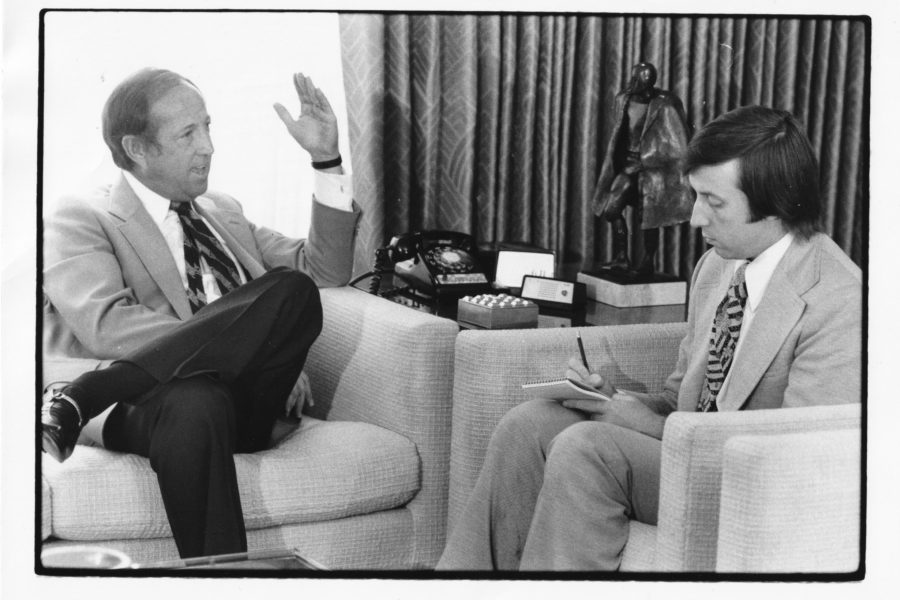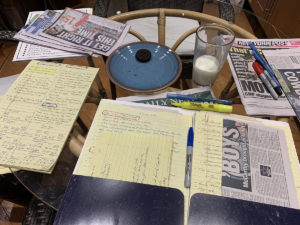
Writing a story about Ray Didinger is akin to going skating with Wayne Gretzky or shooting hoops with Michael Jordan. Sure, it’s going to be fun. Just don’t mess up.
Didinger is to sportswriting what Gretzky was to hockey and Jordan was to basketball, simply the best there ever was. Even though he hasn’t been a “full-time” writer since he left The Philadelphia Daily News in 1996, and younger fans know him better for his weekend radio shows on WIP or his Eagles pre-game and post-game shows on television, Didinger is a writer.
“That’s true,” he said days after he announced he was retiring and days before his final show on WIP. “If someone asks me what I am, I would say a journalist. I never stopped writing, the books, the play, at NFL Films I wrote scripts. I did the TV and radio thing for years, but I’ll always think of myself as a writer. I think writing is one of those things that’s what you are. If you’re a writer, you’re always a writer.”
Anyone can write, but not everyone can be a writer. Didinger did some sort of writing for 53 years. He started at the Delaware County Times, moved to the Philadelphia Bulletin and then The Daily News. He’s written 12 books and the fascinating play “Tommy and Me” about his boyhood hero and later friend, Tommy McDonald. And he did it better than anyone else. And slower.
“I have the record of being the last person out of the press box for 26 straight Super Bowls,” he says with a laugh.
You may have heard that story before as well as several others about the last man on the planet without a cell phone. Here are some things you might not know and how Sister Claire Ursula, a fifth-grade teacher at Queen of Peace grammar school, and George Wallace, the Alabama governor and one-time Presidential candidate, were big influences on Ray’s career. And that his favorite story he ever wrote was not about football.
Let’s start with Sister Claire.
“I knew I wanted to be a writer from a very young age and I was always interested in sports,” Didinger said. “Wouldn’t it be great if I could put those two together and make a living?”
So, in fifth grade, he was given an assignment to write an essay about the person he most admired. While some of the students chose celebrities, sports figures or, being a Catholic school, the Pope, Ray chose his father. Sister Claire approved.
“Two days later she comes in with the stack of papers, and she says ‘Before I hand them back to you. There’s one I want to read to all of you.’ She starts reading it, and all of a sudden, I say to myself, “That’s my essay.’ She goes on to say this essay was written by Raymond Didinger. She looked at me and said, ‘Mr. Didinger you should be a writer.’
“It was the first time someone ever told me I was good at something. Maybe she’s right, maybe this is what I should do.”
Young Ray took the nun’s advice. He wrote for his high school paper, went to Temple University, majored in journalism and wrote some more. When he graduated in June of 1968, he had a job two days later.
“I graduated Friday, and started working for the DelCo Times, Monday,” he said. “No year off spent backpacking across Europe for me.”
Europe? He barely had time to get to the Jersey Shore for the weekend.
“They didn’t have an opening in the sports department,” Didinger said of that first job. “The opening was in news. That’s what they offered me. They knew I wanted sports, but they needed a news reporter.”
The starting salary was $100.25 a week, or as Ray told his father when asked, “A hundred and a quarter a week.”
“I didn’t want to lie to him,” he said. “I was hoping he thought it was $125.”
This takes us to the part about Wallace, the controversial Alabama governor who ran as a third-party candidate against Richard Nixon and Hubert Humphrey for President in 1968. All three candidates were campaigning in the Philadelphia area and swung through Delaware County.
While Ray was on the phone in the office taking a local story from a stringer, the city editor came by and put a slip of paper on his desk. It read: George Wallace, Holiday Inn, Essington, 1 o’clock.
“What’s this?” Didinger asked. “He told me Wallace was having a press conference and he wanted me to go. I’m a kid. Do I really want to go interview George Wallace? He wasn’t exactly my favorite person. I figure I’ll just go stand in the back and listen and take down the answers. It will be easy.”
Ray took the assignment and headed over to the Holiday Inn.
“I look at the paper again and it said, ‘Room 118’. I get there and 118 is just a room. I knock on the door, this state trooper guy answers and I tell him I’m from the Del-Co Times. He says, ‘OK, the Governor is right here.’ There were no other reporters there. It’s just me, the trooper, one other guy who was the press aide and Wallace.
“I hadn’t prepared anything. And he could tell. I’m just a kid and I looked like a kid. It was bad. I didn’t know where to begin. I think I asked him how the Alabama football team was going to do.”
It taught a valuable lesson and led to what has become a standing joke about Ray and his yellow legal pads.
“I was so flustered I told myself this will never happen to me again. I will never go to any assignment unprepared. And you know how people make fun of me for my yellow legal pads. It all started that day. As painful an experience as it was, it was a really valuable lesson to learn.”

Didinger spent just a year writing news in Delaware County. In June 1969, he joined The Bulletin to cover high school football and a year later became the Eagles beat writer.
“I was 23 I was covering high schools for one year. I told my boss, ‘I don’t think I’m up for that,’” Didinger said of the Eagles. “He said it was a great fit.”
He was right.
Didinger covered the Eagles for The Bulletin for 10 years before moving to The Daily News in 1980 as a columnist and feature writer.
While he covered other sports, football was and still is his passion. He was inducted into the writer’s wing of the Pro Football Hall of Fame in 1995 and three years later had a moment even greater than that when he introduced Tommy McDonald for his induction.
“The highlight of my career was clearly Tommy,” Didinger said. “He meant so much to me. We were dear friends. The fact that I was able to help him achieve what he really wanted, the Hall of Fame, by being so persistent. And then for him to turn around and ask me to be his presenter. We got to share that whole weekend.”
Young Ray from Sister Claire’s class used to go to Eagles training camp in Hershey and wait to get McDonald’s autograph. Now some 40 years later he’s riding with him in an open convertible in Canton, Ohio, on the way to the Hall of Fame induction.
“That,” Didinger said, “is the definition of dreams coming true.”
When asked what he felt was his favorite or best story he ever wrote, Ray didn’t pick one about McDonald, or former Eagles head coach Dick Vermeil, or the one where he termed the nickname “Invincible” on Vince Papale. He didn’t choose a football story at all.
“Number one is a Moses Malone profile,” Didinger said when asked that question. “It was 1983, the Sixers were about to win the NBA title and Moses was MVP. I was assigned to do a big take-out on him. He didn’t talk much to the press. But my boss wanted me to do this big take-out, find out what makes Moses tick.”
Ray talked to legendary Sixers beat writer Phil Jasner, who told him it wasn’t going to be easy. But because the boss demanded it, he gave it his best shot.
“I introduce myself to Moses, tell him what I wanted and he said, ‘I’m not talking.’ I told him people here wanted to know who he was. ‘Nobody knew me in Houston either. I like it that way.’
Persistent, as he was in getting McDonald inducted into the Hall years later, Didinger went on a four-city road trip with the team. It was to no avail. Malone didn’t want to talk.
Finally, he tried a different route he went to Malone’s hometown of Petersburg, Virginia to talk to family and friends.
“I called his mother and she wasn’t crazy about talking, either,” Didinger said. “But she agreed. Then when I got there, she was in the hospital. She had a heart attack.”
Still, the story had to be written.
“I interviewed all the people around him, some old friends, old coaches. I sat down and wrote this story about Moses through the eyes of everyone else.”
And it won The Keystone Press Award as the best sports story of the year.
“It was a story I really had to write I couldn’t just lean on quotes. That taught me a lot too.”
Didinger left The Daily News in 1996 to work on “Football America” a movie for NFL Films and was hired full-time by them less than a year later.

He joined WIP in 1987 when the station went to its all-sports format and became a part of what was then called Comcast Sports in 1996 when it debuted. But as he said earlier, he’ll always be a writer.
“I love it. It was what I was meant to do,” Didinger said. “I feel fortunate that I came along during the last great wave of sportswriters. I sat next to Jimmy Cannon at an AFC Championship Game, Red Smith at a Super Bowl.
“Back then newspapers were king. And I got to see those guys, meet those guys, work with those guys.”
There’s at least one sportswriter, and probably hundreds more, who would say the same about Ray Didinger.

